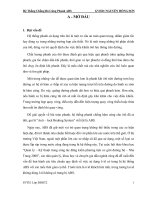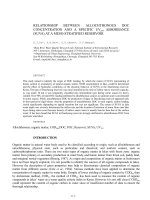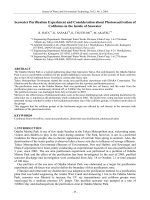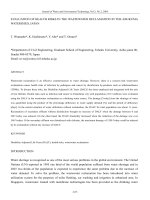Dfd6 ac9437 dd10 ec1 d49 a8288284 ab
Bạn đang xem bản rút gọn của tài liệu. Xem và tải ngay bản đầy đủ của tài liệu tại đây (254.35 KB, 5 trang )
EXPLANATION
ON NOTATION
AND ARRANGEMENT
ABSORBING SYSTEM
An absorbing system consists of a chromophore or conjugated chromophores, printed in
bold face type in Table I, and an atom or atoms, if any, joined to the chromophore or conjugated chromophores, and sometimes, consists merely of auxochromic atoms.
e.g.
compound
absorbing system
notation
Rules determine the notation and sequence of absorbing systems, as mentioned below.
PRINCIPLE OF CITING AND ARRANGING ABSORBING SYSTEMS
Rule 1. The more predominant factor in an absorbing system is cited as early as
possible. Absorbing systems having a more predominant factor are placed later in the
tables.
For example, C:C predominated over C:C as mentioned in Rule 3, and therefore the
chromophore of butenyne is denoted such as CiC - CiC (not CiC - CiC), and CiC precedes CiC
in the tables.
PREDOMINANCY OF ATOMS AND BONDS
Rule 2. The order of increasing predominancy of atoms or elements is as follows:
H,C, and other atoms in the order of ascending group number of the Periodic Table
and increasing atomic number in the group.
Rule 3.
The order of increasing predominancy of bonds is as follows:
single bond < coordinate bond < double bond < triple bond
(An expression a < b indicates that b predominates over a.)
NOTATION OF UNIT CHROMOPHORE
1. Aliphatic chromophores are denoted by atomic symbol and sign of unsaturated bonds.
e.g.
CiC CiC CiCiC NiN N i N i N NiC NiC N i C i N
PiP OiN OiCiC OiAs SiC SiCiS SiCiN SiCiO
Nitro and azoxy chromophores are denoted as Q i N an<3 N i N > respectively. Chromo-
O
O
phores of carboxylic acid (including ester), and its derivatives of type -CO-X such as
amide, halide, and thiolic acid (including ester) are regarded as an unit chromophore
and denoted as:
OiC
OiC
OiC
OiC
6
ft
61
s
Chromophores of carbonic acid (including ester), and its derivatives such as
H2N-CO-NH2, H2N-COOH, (HS)2CO, COCl2 are regarded also as an unit chromophore and denoted
as
OiCO2,
0'.CN2,
OiCON,
OiCS2,
OiCCI 2 .
2. Benzene chromophore is denoted by Arabic numeral 6, and carboaromatic condensed
chromophores are denoted by Arabic numerals with or without subscript Arabic numerals,
respectively indicating the number of atoms in each ring and the number of rings, cited
in the decreasing order of the numerals denoting number of atoms.
e.g. naphthalene 66, azulene 75, indacene 655, anthracene and phenanthrene 63
3. Heteroaromatic chromophores are denoted by atomic symbol with or without subscript Arabic numerals, respectively indicating the kind and number of the hetero-atom,
and the notation of the corresponding carboaromatic chromophore.
e.g. thiophene S5, pyridine N6, indene N65, pyrimidine N26, purine N^65,
thiazole SN5, benzothiazole SN65
4. Fulvenoid, quinonoid, and tropoquinonoid structures are denoted by symbols representing the corresponding genuine aromatic chromophore, the exocyclic double bond(s),
and the atom(s) joined to the exocyclic double bond(s).
e.g. methylenecyclopentadiene (fulvene) 5*.C, dihydropyridinone (pyridone) NGiO,
pyranone (pyrone) 06.'O, tropone 7iO, methyleneindole N65iC, benzoquinone diimine N'.6iN, naphthoquinone Oi66iO, dihydromethylenefuranone (methylenecrotonolactone)
0.05.C, tropoquinone ^i 7!O
PREDOMINANCY OF UNIT CHROMOPHORE
Rule 4. The predominancy of unit chromophores is determined by applying the following criteria in series until-a decision is reached.
a) Heteroaromatic unit chromophores predominate over carboaromatic unit chromophores, which predominate over aliphatic unit chromophores.
e.g. CiC < 66 < N6
b) The predominancy of heteroaromatic unit chromophores is determined first by
hetero-atoms contained in the ring, from the point of (i) the predominancy of the most
predominant hetero-atom and, if there is a choice, of the subsequent predominant heteroatom(s), (ii) a larger total number of hetero-atoms, and (iii) a larger total number of
the most predominant hetero-atom and, if there is a choice, the subsequent predominant
hetero-atom(s).
Examples for (i) :
N6iS < 05, N665 < 065 < S5, 06 < ON5, ON5 < OP5
for (ii):
SN65 < SN265
for (iii): SN265 < S2NSS, SeSN2665 < SeS2^eS
c)
The most predominant is that containing a larger total number of rings.
e.g. 6 < 75 < 63, SN5 < SN65, O i 6 i O < 66
d)
The most predominant is that containing a larger ring.
e.g. 5iO < 6 < 7iO, 55 < 65iO < 66 < 75 < 76iO, N5 < N6 < N7iO
e) The predominancy increases with the sequence of genuine aromatic, fulvenoid,
quinonoid, and tropoquinonoid structures.
e.g.
6 < 0.6.0,
7iO < £i7iO,
N6 < N6iO < OiN6iO
f) The predominancy of aliphatic unit chromophores is determined first by componental atoms, from the point of (i) the predominancy of the most predominant componental
atom and, if there is a choice, of the subsequent predominant componental atoms(s), (ii)
a larger total number of componental atoms joined with unsaturated bond(s), and (iii) a
larger total number of the most predominant componental atom and, if there is a choice,
of the subsequent predominant componental atom(s).
Examples for (i) :
for (ii):
for (iii):
g)
CiC < NiN < NX < OiC < OiN < O i C i N < O i A s
CiC < C i C i C , OiC < OiCiC, OiC < OiCiO, N i C < N i C i N
NiCiC < NiCiN
The most predominant is that containing a more predominant bond.
e.g.
CiC < CiC, NiC < NiC
h) The more predominant is that containing a larger total number of a more predominant componental atom(s) joined with coordinate bond(s) or a single bond(s) to the
atom joined with unsaturated bond(s) and, if there is a choice, the subsequent predominant componental atom(s) similarly joined.
e.g.
OiC < OiC < OiCN 2 < OiC < OiCON < OiC < OiCS2 < OiCSO < OiC < OiCCI 2 ,
OiN < OiN, NiN < NiN
A
O
NOTATION OF CONJUGATED CHROMOPHORES
Conjugated chromophores are denoted by the notation of componental unit chromophores
joined by a hyphen.
e.g.
CiC-CiC,
OiC-CiC-CiO,
OiC-66-CiC,
Q*.£>N66-CiO
When there is a choice, the direction is so chosen as to make the most predominant
chromophore and, if there is a choice, the subsequent predominant chromophore(s) come
as early as possible.
N * r*
e.g.
CiC-CiC,
OiC-6
OiC-NiC-CiC,
Oi(T^0'
NiC<£:£
6-CiC, CiC-6-CiC, 6e-6, Ne-6, S6-6-N6
Sometimes, the notation of unit chromophores in conjugation may be reversed, such as
N i C to CiN in 6-C:N.
NOTATION OF AUXOCHROMIC ATOMS
Auxochromic atoms are denoted by atomic symbol(s) joined by a hyphen to the atom in
the chromophore. Hydrogen atom is not regarded as an auxochrome, and not necessary to be
denoted.
^
e.g.
C-CiC-CiC-C, NiC-C, 0-NiC-C2 (not 0-NiC<c>, OC-6,
C1-N6
When there is a choice, the direction is so chosen as to make the symbol of the most
predominant auxochromic atom, and if there is a choice, that of the subsequent predominant auxochromic atom(s), come as early as possible.
e.g.
C-CiC-CiC (not CiC-CiC-C)5 CiC-CiC (not CiC-CiC)
Cl
Cl
CiC-CiC-C (not C-CiC-CiC), C-CiC-CiC (not CiC-CiC-C)
ii
ii
ii 61
ci ci
NOTATION OF LONG CONJUGATED ABSORBING SYSTEMS
In addition to the above measures, sometimes, long conjugated absorbing systems may
be denoted in an abbreviated manner.
e.g.
(CiC)5~C4 instead of C-CiC-CiC-CiC-CiC-CiC-C
£
i
&-[CiC]5-6 instead of 6-CiC-CiC-CiC-CiC-CiC-S
NOTATION AND ARRANGEMENT OF AUXOCHROMIC SYSTEM WITHOUT CHROMOPHORE
Auxochromic systems such as methane, chloromethane and bromomethane, have no chromophore, and they are treated as absorbing systems of no chromophore.
PREDOMINANCY OF ABSORBING SYSTEMS
Rule 5. The predominancy of absorbing systems is determined by applying the follow-
ing criteria in series until a decision is reached.
a) The predominancy is determined first by the most predominant unit chromophore
and, if there is a choice, the subsequent predominant unit chromophore(s), contained in
the absorbing system, from the point of (i) being predominant, (ii) being larger in total
number, and (iii) being cited earlier.
Examples for (i) :
CiC-CiC-CiC < CiC-CiC < CiC-CiC < NiC-CiC-CiC < 6 < S-C.O <
NiSiC-S < N6-c:c
for (ii):
for (iii):
OiC-CiC-CiC < OiC-CiC-CiC-CiC < OiC-CiC-CiO
CiC-CiC-CiC < CiC-CiC-CiC, NiC-CiC-CiC < NiC-CiC-CiC
b) The predominancy is determined by earlier appearance of (i) the most predominant
atom and, if there is a choice, the subsequent predominant atom(s), in the most predominant unit chromophore, and of (ii) the most predominant atom and, if there is a choice,
the subsequent predominant atom(s), in the subsequent predominant unit chromophore(s).
Examples for (i) : CiN-CiC < NiC-CiC
for (ii):
NiC-CiC-CiN < NiC-CiC-NiC
c) The predominancy is determined by the most predominant auxochromic atom and, if
there is a choice, the subsequent predominant auxochromic atom(s), joined to the most
predominant atom in the most predominant unit chromophore, from the point of (i) being
predominant, (ii) being larger in total number, and (iii) being cited earlier.
Examples for (i):
C-NiC-CiC < N-NiC-CiC < 0-NiC-CiC,
BrN-S-CiC < BrCl-G-CiC
for (ii):
ClC3-S-CiC < Cl2C-S-CiC, ClC-S-CiC < ClC2-S-CiC
for (iii): CiC-CiC < C-CiC-CiC
Criteria (c) to (f) determine the predominancy of absorbing systems by the nature
of auxochromic atoms joined to the chromophores. When applying these criteria, the predominancy of C atoms of carboaromatic and heteroaromatic unit chromophores is -regarded
as same as that of C atoms of CiC, and the predominancy of hetero-atoms of heteroaromatic
unit chromophores is regarded as higher than that of C atoms of CiC and lower than that
of C atoms of CiCiC, in order to make the determination by these criteria accord with the
optical properties of absorbing systems.
e.g. C-S-CiC-CiCiC < S-CiC-CiCiC-C, Br-S-CiN-N < Cl-fr-CiN-0
d) The predominancy is determined similarly to (c) by the most predominant auxochromic atom and, if there is a choice, the subsequent predominant auxochromic atom(s),
joined to the subsequent predominant atom(s) in the most predominant unit chromophore.
e.g. C 2 -NiC-CiC < C 2 -NiC-CiC
e) The predominancy is determined similarly to (c) by the most predominant auxochromic atom and, if there is a choice, the subsequent predominant auxochromic atom(s),
joined to the most predominant atom in the subsequent predominant unit chromophore(s).
e.g. NiC-CiC-CiN-N < NiC-CiC-CiN-O
f) The predominancy is determined similarly to (c) by the most predominant auxochromic atom and, if there is a choice, the subsequent predominant auxochromic atom(s),
joined to the subsequent predominant atom(s) in the subsequent predominant unit chromOphore(s).
e.g. NiC-CiC-CiN-C 2 < NiC-CiC-CiN-C2
NOTATION AND ARRANGEMENT OF CROSS-CONJUGATED CHROMOPHORES
The direction denoting cross-conjugated chromophores is so chosen as to make the
most predominant linear conjugation and, if there is a choice, to make the subsequent
predominant linear conjugation(s) come as early as possible.
<•*- o:c
linear conjugation.









